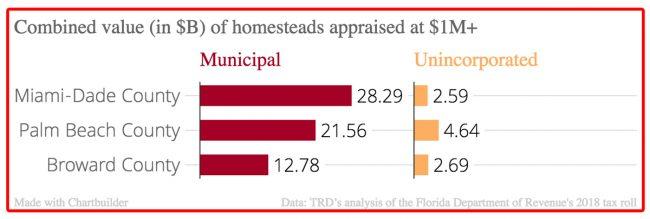In the fall of 2016, Roger Ailes was by all accounts a very wealthy man. Fox News had just pushed him out from the company he built over allegations of sexual harassment, but paid him $40 million for his troubles. So he did what many other rich retirees before him have done: he bought a house in Florida.
Through a trust, Ailes paid $36 million in cash for a six-bedroom, 12,747-square-foot mansion in Palm Beach. In November that year, the longtime Putnam County, NY resident filed a declaration of domicile in Florida, public records show, making the new property at 6 Ocean Lane his primary home.
The declaration had its perks. Ailes was a defendant in a potentially expensive sexual-harassment lawsuit by former Fox News host Andrea Tantaros and was about to become a defendant in another, by former contributor Julie Roginsky. A judgment against him could put his assets on the line. But making the Palm Beach mansion his primary residence could insulate the house and up to half an acre of land around it from any legal claims, thanks to a handy Florida law known as the “homestead exemption.”
Ailes died in May 2017 at age 77. Fox News, also a defendant in the suits, settled Roginsky’s lawsuit in December of that year and Tantaros’ lawsuit was dismissed in May 2018. Ailes’ widow, Elizabeth Ailes, declared the Palm Beach property her homestead for tax purposes in 2017 and 2018, property records show. A spokesperson for Elizabeth did not respond to requests for comment.
Curious if someone of means is in a financial pickle? Check if they recently bought a mansion in Florida or Texas.
Paying millions for a palatial home in the Sunshine State is usually an indicator of unfettered wealth. But it could also be a warning sign that the buyer may be trying to protect money from creditors or legal claims. Florida and Texas are among the few states with a so-called unlimited homestead exemption, a law enshrined in the state constitution stipulating that your home is off limits to creditors, no matter how much it is worth or how much you owe. For people staring down big debts or potentially costly lawsuits, this creates a powerful incentive to buy the priciest property they can find in a homestead state.
For people staring down big debts or potentially costly lawsuits, this creates a powerful incentive to buy the priciest property they can find in a homestead state.
Rising home prices mean more wealth is now beyond the reach of creditors. In three South Florida counties — Miami-Dade, Broward and Palm Beach — alone, the combined appraised value of all luxury homes appraised at $1 million or more whose owners claim the homestead exemption in tax filings is $69.9 billion (see chart), according to The Real Deal’s analysis of the Florida Department of Revenue’s 2018 tax roll. The true market values of these properties could be much higher.*
“If you go to a lawyer and ask ‘how do I protect my assets?,’ the first thing they say is: ‘Buy a valuable homestead,’” said Jeffrey Davis, a law professor at the University of Florida. “Some people just sort of call it estate planning.”
Some people just sort of call it estate planning.
Funny laws
Residents of most U.S. states get a homestead exemption protecting some of their home equity from creditors. In California, for example, most people have a cap of $75,000, while in Virginia, the cap is $5,000.
Florida, Texas, Kansas, Iowa, Oklahoma and South Dakota, however, have no limit. In these states, buying an expensive property and claiming the homestead exemption has some of the perks of stashing your money in an offshore account — protection from creditors and lawsuits — without having to transfer money overseas.
“If you’re faced with losing what you have, the psychological toll it takes on you is the same whether you’re really rich or an average Joe,” said Wayne Patton, a Miami-based asset-protection attorney. “So the idea of moving somewhere where you can protect the bulk of what you have is very appealing.”
The list of the rich and famous who have taken advantage of the exemption is long, and it includes NFL legend O.J. Simpson, movie star Burt Reynolds and one of the original Miami Worldcenter developers, Marc Roberts.
Simpson had spent much of his life in California, but bought a home in Miami for $575,000 in 2000 and moved there after he lost a $33.5 million civil suit brought by the relatives of his murdered ex-wife.
“They got funny laws in this state,” Simpson told the New Yorker in 2001, explaining why he likes living in Florida.
The unlimited exemption has been around for more than a century, but its popularity is on the rise. Several offshore financial centers have increased transparency and made life harder for those looking to hide money abroad. Meanwhile, Florida’s rising property market over the past decade has made buying homes there more attractive.
In both Florida and Texas, debtors need to actually move into the property and show that they want to make it their permanent residence – by changing their voter registration, for example – to get the exemption. But they do not need to have lived in it for long. There are exceptions: those who buy a home with proceeds from criminal activity aren’t protected, and homeowners who fail to pay taxes or don’t make mortgage payments on their homestead can still see it seized.

10000 Holloway Way Drive
Evading creditors isn’t the main reason people claim the homestead exemption, asset-recovery lawyers say. Making a property your homestead carries significant tax benefits.
But even if people buy a property purely and explicitly to bilk their lenders, that’s totally legal – at least in Florida.
In 2001, the state’s Supreme Court ruled that the exemption protects a property owner even if she bought the home with “the specific intent of hindering, delaying, or defrauding creditors.” The ruling has turned into a nightmare for lenders and asset-recovery lawyers nationwide. Because many debtors across the U.S. can, in theory, move to Florida at a moment’s notice and buy a house, they know that a part of their fortune equivalent to the value of a hypothetical Florida mansion can’t ever be seized by creditors. Of all of Florida’s eccentric laws, the homestead exemption is the one it sort of managed to force on the rest of the country as well.
“We’ll have a lawsuit against somebody where they will say ‘you can sue me, and might even win, but by the time you win I’m going to sell my house up here and all my other assets and I’m going to buy a house in Florida’,” said Schuyler Carroll, a New York-based asset-recovery attorney at Perkins Coie, adding that he’s been involved in dozens of cases where the exemption came up. “So we settle.”
Paupers with palaces
Tom Hicks made a fortune as a private-equity investor and a name for himself as the owner of the Texas Rangers baseball team and English soccer club Liverpool F.C. But the Dallas resident found himself in deep trouble after the financial crisis. In 2010, the Rangers filed for bankruptcy, and Hicks sold the team to pay off his creditors. In 2011, a group of former Rangers investors sued Hicks, claiming he had used the team to improperly enrich himself. JPMorgan Chase reportedly sought $35.4 million from him.
As Hicks fought for what was left of his wealth – he had also been forced to sell Liverpool F.C. – he could be fairly certain of one thing: no one could take away his palatial Dallas estate.
Hicks had bought the nearly 30,000-square-foot home at 10000 Holloway Drive in 1999 — the year his Dallas Stars hockey team won the Stanley Cup. Built by architect Maurice Fatio for Italian aristocrat Pio Crespi in the 1930s, the 25-acre property includes a library decked in walnut wood, crystal chandeliers, two guest houses, a pool and a lake. In 2013, Dallas County appraisers valued the property at $40 million. Property records show that Hicks claimed the homestead exemption on the property.
“He was pleading poverty, but everyone knew he had this absolutely phenomenal house,” recalled a source familiar with the Rangers bankruptcy. An attorney for Hicks declined to comment for this article.
Hicks can thank an earlier banking crisis for the law that shielded his mansion. In 1837, a year after Texas declared its independence from Mexico, a financial panic hit the U.S., leading to a wave of loan defaults and bank failures. The crisis would have a lasting impact on the state’s laws, according to Michael Ariens, a legal historian at St. Mary’s University.
“When Texas became a state in 1845, the idea that creditors could take the essentials of a farmer’s or workman’s way to earn a living was anathema,” Ariens said. “And there are always more debtors than creditors as voters.”
He was pleading poverty, but everyone knew he had this absolutely phenomenal house,
The homestead exemption eventually became a “sacrosanct” part of the constitution, according to Joe Wielebinski, a Texas-based asset-recovery attorney at Winstead PC. “Texas is a state with a history of people from other areas coming to this free, open and large state for a lot of reasons,” he said. “Whether it’s embarrassing or not, one of the reasons they came here was to avoid creditors in other states.”
In Texas, the debtor protection covers up to 10 acres in cities and up to 100 acres for an individual (200 for a family) in the countryside from creditors. In Florida, which included the exemption in its constitution in 1868, it covers just half an acre in a municipality and 160 acres outside a municipality. But as property prices in Miami and Palm Beach rose in the 1990s and early 2000s, debtors realized that they could squeeze a lot of money into half an acre.
there are always more debtors than creditors as voters.
So sue me
In late 1989, former Major League Baseball commissioner Bowie Kuhn’s Manhattan law firm went bankrupt. Weeks later, Kuhn bought a $1 million, five-bedroom home in Ponte Vedra Beach and claimed the homestead exemption.
“There is nothing inappropriate about my actions,” he told the New York Times in 1993: “People do this all the time.”
In 1996, Burt Reynolds filed for bankruptcy but kept his $2.5 million property near Palm Beach. Paul Bilzerian, a former corporate raider who went bankrupt in Florida for the second time in 2001 with $140 million in debt, got to keep his $5 million, 11-bedroom home in Tampa Bay, which included an indoor basketball court and a cinema.

Roger Ailes’ Palm Beach property at 6 Ocean Drive
Martin Kenney, a British Virgin Islands-based asset-recovery lawyer, recalls representing a hedge fund in the early 2000s. The fund had lent $20 million to a Florida doctor, who defaulted on the loan and pleaded poverty even though he owned a $7 million home near Sarasota, according to Kenney.
“We didn’t litigate over the house because we thought, ‘why do that if you’re just going to waste your time and lose?’” he said. “Like all policy choices, you end up with people that are unethical, abusing the privilege, doing things that probably the folks who created that homestead law never envisioned would happen.”
As abuse spread, the banking industry lobbied to change bankruptcy laws, facing fierce resistance from the real-estate industry and property owners in homestead states. In 1998, George W. Bush, then governor of Texas, wrote a letter to the House Judiciary Committee arguing that a “homestead cap is a clear violation of states’ rights with regard to state private property.” Current Attorney General Jeff Sessions, then a senator representing Alabama, found himself on the other side, telling the Times in 2001 that the unlimited exemption “isn’t just.”

Burt Reynolds (Credit: Wikipedia)
The bankers prevailed and in 2005, Congress passed the Bankruptcy Abuse Prevention and Consumer Protection Act. It stipulated, among other changes, that those who file for bankruptcy can no longer claim the unlimited exemption unless they have lived in the property for at least 40 months.
“If a bankruptcy filing occurs today, it’s not clear that a homestead is bulletproof from all creditors’ claims,” said Wielebinski, the asset-recovery attorney. “Thirty years ago, if you put money into your homestead you were virtually immune from the claims of all creditors except for the mortgage lender and taxes. So it’s a dramatic change.”
The housing crisis further eroded the appeal of the exemption. Property prices plummeted, and there’s no point in claiming the exemption on a home that’s underwater anyway.
“Since 2008 we saw less people claiming it because there was no equity in the house,” said Michael Bakst, a Palm Beach-based attorney at Greenspoon Marder who specializes in bankruptcy and insolvency cases.
But as the Florida real estate market recovered from the crisis and the state attracted more of the world’s wealthy, so did the homestead exemption.
Marc Roberts, a former boxing promoter and one of the original developers behind the Miami Worldcenter project, claimed the homestead exemption on his $1.5 million home in Jupiter, Florida, when he filed for bankruptcy in March 2010, court records show. Roberts could not be reached for comment.
Keurig Green Mountain founder Robert Stiller reportedly paid $55 million for a mansion in Palm Beach through an LLC in January 2014 while he was still a defendant in three shareholder lawsuits against Green Mountain. He already owned a home in the same town but soon declared the new property his homestead, public records show. Although there is no indication Stiller bought the property because of the exemption, his role as a defendant meant he could potentially benefit from the law. An attorney representing Stiller did not comment.
The exemption continues to be highly effective. Gregory Grossman, a Miami-based asset-recovery attorney at Sequor Law, said he was unable to contest the exemption on behalf of creditors in more than 95 percent of the cases he was involved in.

And even the fact that your money is tied up in your home isn’t too much of a problem for those with patience.
Take Tom Hicks. While the lawsuits against him dragged on, he continued to claim the Dallas estate as his primary residence. Then, in late 2012, Hicks settled a legal dispute with the Rangers, and on January 11, 2013, a lawsuit brought by his lenders was dismissed.
Two weeks later, news broke that Hicks had put the home on the market for $135 million — at the time reportedly the most expensive residential listing in the country. He later cut the asking price to $100 million and sold it in January 2016 for a reported $58 million.
*Note on methodology: TRD only counted the appraised value of the building and the appraised value of the land for up to half an acre in municipalities and 160 acres outside. For example, if a one-acre plot of land in a municipality was appraised at $2 million, we would add $1 million to the count for the half acre protected by the exemption.
